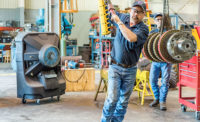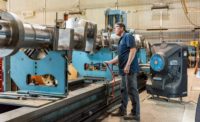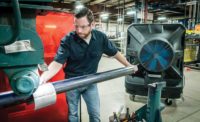According to the Occupational Safety and Health Association (OSHA), thousands of workers become sick from occupational heat exposure each year. However, heat-related illnesses are preventable. “The best way to prevent heat-related illness is to make the work environment cooler,” OSHA states.
It is important to understand how the body handles heat and hot conditions when evaluating the potential for employee heat-related illnesses. As temperatures rise, the body releases heat more slowly. As humidity increases, sweat evaporation decreases and stagnant air makes sweat evaporation even more difficult. When these three factors are combined, you have a higher potential for health and safety concerns. The chances for accidents due to sweaty hands, dizziness and decreased mental alertness go up considerably.
Additionally, increased body temperature and discomfort can lead to irritability and frustration that could lend to more careless behavior. This puts the worker and the work environment at risk when one is not properly prepared for the heat.
Given that most heat-related health problems can be prevented, or at least the risk of developing them can be reduced, taking a proactive approach gives two-fold benefits. You will effectively ensure worker safety and in-turn, productivity. Both will positively benefit the company’s bottom dollar.
Prevention – preventative steps on the jobsite
- Acclimating workers is a necessary process even if it seems counterintuitive to generating productivity (e.g., a reduced work shift during excessive heat). An effective heat acclimatization program gradually increases an unacclimated worker’s exposure to heat over a 7- to 14-day period.
- Make sure to have plenty of fluids on hand. Workers need plenty of water throughout the day (approximately every 15 minutes) in hot conditions and shouldn’t wait until they feel thirsty.
- Schedule rest breaks to help your body recover. OSHA advises workers to rest in the shade or in air-conditioning when possible to help cool down. Utilize or add cooling stations on worksites when possible with tools such as a portable evaporative cooler that work on a standard 110-V electricity supply.
- Stay aware of conditions with your phone or tablet, especially if working outdoors. Working in full sunlight can increase heat index* values by 15°F. OSHA has an app (download info here) to help calculate the heat index for the worksite and helps to identify the risk level.
- Be sure workers are informed by reviewing the heat illness signs and symptoms. Training is this area is worthwhile.
- Use a buddy system. Encourage workers to monitor each other for signs and symptoms of heat-related illness.
(*For more information about safety while working in the heat, see OSHA's heat illness webpage and online guidance page for employers that outlines how to use the heat index to protect workers.)







